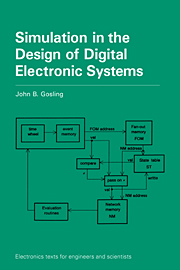Book contents
- Frontmatter
- Contents
- Preface
- 1 An introduction to the simulation of electronic systems
- 2 Electronic computer aided design (ECAD) systems
- 3 Design for testability
- 4 Exercising the design in simulation and test
- 5 Input/output of simulation and specification of models
- 6 Simulation algorithms
- 7 Models and model design
- 8 Timing verification
- 9 Fault simulation
- 10 Simulator features and extensions
- Appendix
- References
- Index
1 - An introduction to the simulation of electronic systems
Published online by Cambridge University Press: 05 June 2012
- Frontmatter
- Contents
- Preface
- 1 An introduction to the simulation of electronic systems
- 2 Electronic computer aided design (ECAD) systems
- 3 Design for testability
- 4 Exercising the design in simulation and test
- 5 Input/output of simulation and specification of models
- 6 Simulation algorithms
- 7 Models and model design
- 8 Timing verification
- 9 Fault simulation
- 10 Simulator features and extensions
- Appendix
- References
- Index
Summary
Introduction
A few years ago a well known company stated that the size of silicon chip that could be designed and built would be limited by ‘engineer blow-out’ – what a single engineer could hold in his mind without going crazy. To overcome that limitation, techniques for ‘managing complexity’ have been developed. These have included methods for manipulating data in different ways. The computer can handle large quantities of data without becoming crazed and without error, leaving only the interesting and intelligent work to the engineer.
Computer aids are not limited to chip design. It is not difficult today to produce a chip which works first time according to its specification. But was the specification correct? Thus there is no point in designing a 10 million gate chip which works perfectly to specification if the specification is wrong. In the late 1980s, estimates varied in the region 10% to 50% that the chip would work within its intended system (Harding 1989, Hodge 1990). This was clearly unsatisfactory, so there has been increasing emphasis on the need for system design rather than purely chip design.
One of the problems with building hardware is that, once built, it is not easily changed. In the case of designing on silicon, change is impossible. It is estimated that the relative cost of finding faults at design time, chip-test time, printed circuit board construction time, or in the finished machine in the field is 1:10:100:1000 (Section 3.1.1).
- Type
- Chapter
- Information
- Publisher: Cambridge University PressPrint publication year: 1993



